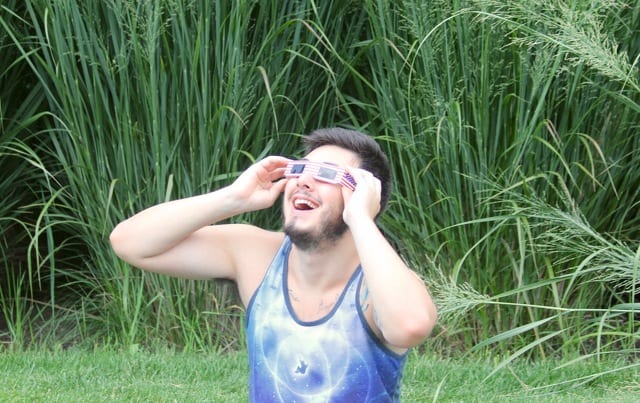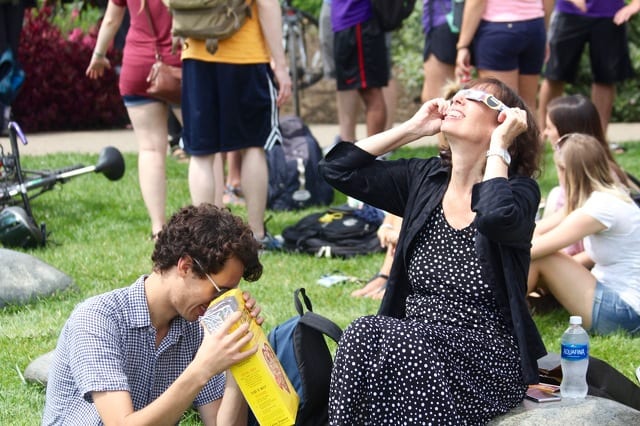It seemed on Monday afternoon that, to paraphrase Pink Floyd, everyone under the sun was in tune.
In the State College area, thousands turned out for community gatherings or just stepped outside their homes and offices to get a look at the solar eclipse. Pennsylvania wasn’t in the ‘path of totality,’ from Oregon to South Carolina that saw a total solar eclipse, the first in the contiguous United States since 1979. Still, Central Pennsylvania saw a partial eclipse which began at 1:15 p.m., reached its maximum of about 80 percent coverage at 2:39 p.m. and would end at about 4 p.m.
Here’s what #SolarEclipse2017 looked like above State College this afternoon if you missed out on it.
( : @m_sniegowski) pic.twitter.com/nJFkavRfo1
— Onward State (@OnwardState) August 21, 2017
The Arboretum at Penn State was one of three locations where Penn State’s Department of Astronomy and Astrophysics hosted gatherings where students and faculty handed out safety glasses to view the eclipse.
The department got as many of the glasses as it could. In recent weeks they’ve been hard to come by and prices through online outlets have soared. So while not everyone could get their own, there was plenty of sharing at the Arboretum.
‘We thought it would be large, so it’s not surprising,’ said Kevin Luhman, professor of astronomy and astrophysics. ‘It’s a very rare event. For any given location on Earth, a total eclipse happens only once about every 400 years.’
The next total eclipse in the U.S. will be in 2024, with a path of totality stretching from Texas through main and including a small portion of northwestern Pennsylvania, according to NASA. The last time the area that now includes State College experienced a total solar eclipse was in 1451, Luhman said, and another still won’t happen here for about 100 more years.
An 80 percent eclipse was still enough to draw massive interest around town. Luhman said rare events like an eclipse provide an educational opportunity
‘It definitely sparks interest in astronomy and people learning about the sun, moon and Earth,’ he said.
For Eileen Fabian, of State College, that’s one of the aspects that drew her to view the eclipse at the Arboretum
‘One reason I came up is because it was being hosted by the astronomy department, so there’s more science to it and they made it safe for people to view,’ Fabian said. ‘And this is a beautiful location to be at to see it.’
She was joined by Lisa and Kyle Posey of State College, and together they shared a pair of safety glasses as well as a pinhole camera. A popular tool on Monday afternoon, the device uses an empty cereal box or other cardboard to project the image of the eclipse onto a surface, so that you’re not looking directly at the sun.

Lisa Posey, left, views a projected image of the eclipse through a pinhole camera while Eileen Fabian uses eclipse safety glasses on Monday afternoon at the Arboretum. Photo by Geoff Rushton/StateCollege.com
While clouds moved in during the early afternoon and a threat of rain appeared, the sun was frequently visible and those with safe viewing equipment could see the eclipse.
Connor Lomb, a Penn State senior was one of them. He staked out a somewhat secluded spot in the botanical gardens, where he had a pair of eclipse glasses his father, an astronomy buff, got for him months ago.
‘I was looking for the best places to view and this seemed like the best place,’ Lomb said. ‘I got here and was surprised to see hundreds of other people came to the event… I don’t know much about the science of it, but I know it’s an incredible opportunity.’

Connor Lomb views the eclipse through safety glasses on Monday afternoon at the Arboretum. Photo by Geoff Rushton/StateCollege.com
The Arboretum wasn’t the only popular gathering spot on Monday. With it being the first day of classes at Penn State and the building’s central campus location, Davey Laboratory, home to the astronomy department’s rooftop observatory, saw lines going out of the building and onto the Pollock Road sidewalk.
The line to enter the Davey Lab Observatory is out the door and starting to stretch around the buillding. pic.twitter.com/I8Auyhm4oT
— Onward State (@OnwardState) August 21, 2017
Mount Nittany Middle School was another location where the astronomy department handed out safety glasses.
SCASD students watching The solar eclipse at Mount Nittany Middle School. @MNMSRoar #SolarEclispe2017 pic.twitter.com/0rQWtIhvCI
— State College SD (@StateCollegeSD) August 21, 2017
Smaller gatherings could be seen all over campus and around town. Even Penn State President Eric Barron joined in outside of Old Main.
‘I’m doing all right, getting good grades, the future’s so bright I gotta wear shades’ pic.twitter.com/ywmGsvG0rt
— Onward State (@OnwardState) August 21, 2017



